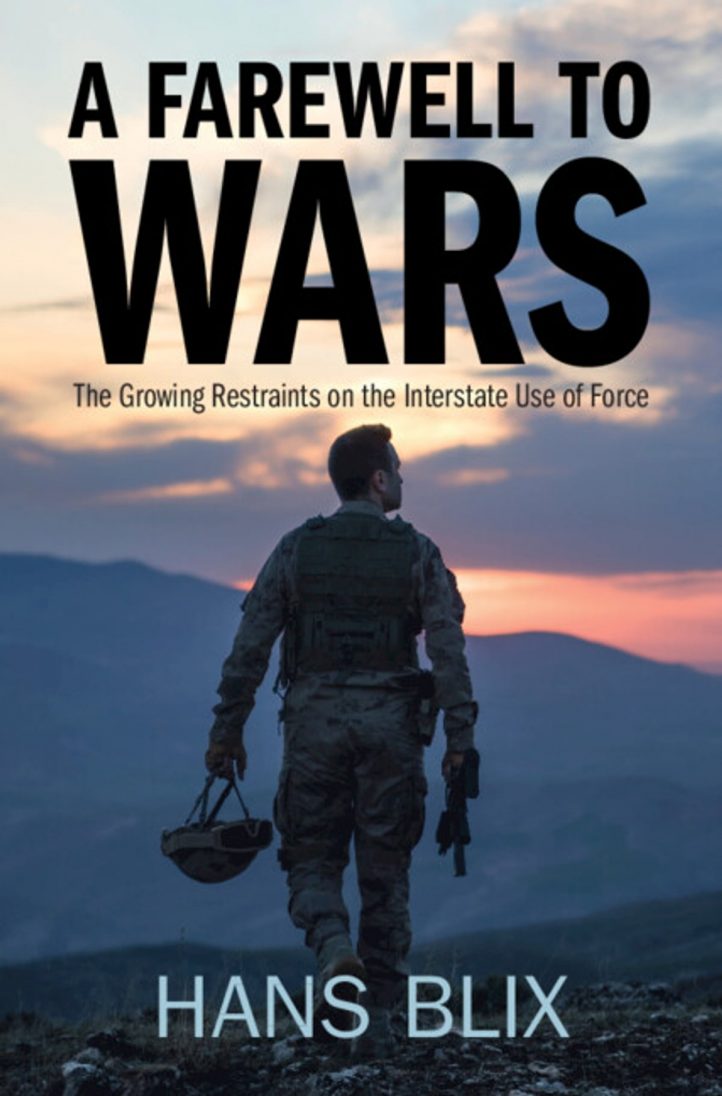Book Reviews: A Farewell to Wars

In the shadow of the conflicts in Ukraine and the Middle East it is challenging to imagine a farewell to wars. Hans Blix’s latest book surveys modern international relations, and with the critical mind of a lawyer and diplomatic practitioner, demonstrates how, over the last two centuries, the international system has accepted growing constraints on interstate use of force.
Indeed, he argues that with rare cases excepted, the international community has said farewell to direct interstate wars and is in the process of ending the use of naked force in interventions. However, that does not anticipate an end to interstate competition. Rather that competition is now conducted through less overtly violent means, which present their own challenges to international peace and security.
Hans Blix is perhaps best remembered as the head of the United Nations’ Iraq WMD (weapons of mass destruction) inspection mission (UNMOVIC). In that role he stood up to Saddam Hussein’s deceptions while resisting the pressures of George W. Bush and Tony Blair to provide non-existent evidence of banned weapons. He documented those years in his memoir “Disarming Iraq: The Search for Weapons of Mass Destruction.” An international lawyer, he served as a Swedish diplomat and foreign minister before being elected to the head the UN’s nuclear watchdog, the International Atomic Energy Agency (IAEA), a position he held from 1981 to 1995, covering the dramatic final decade of the Cold War and the early post-Cold War years of high hopes for containing global nuclear threats.
Among many honours, he was awarded the Sydney Peace Prize in 2007 for his life-long advocacy of humanitarian law and for leadership of disarmament programs to rid the world of weapons of terror.
A Farewell to Wars traces the evolution of international law as it relates to interstate conflict. It is very accessible to the non-lawyer and would be an excellent primer on the subject for students or practitioners of international relations. He notes that the book does not purport to be a scholarly or comprehensive examination of the subject, rather one reflecting actual engagement in the workings of the UN system, both as a national representative and a very senior official within the system. It is rich in personal reflection and wry comment on the foibles, failures, but also achievements of multilateral diplomacy and international law.
The introduction includes a framework of the philosophical traditions underlying thinking about the management of world affairs – from Thomas Hobbes to Hans Morgenthau, Francis Fukuyama, and Azar Gat. Whereas states are expected to perform the role of Hobbes’ leviathan, the international community lacks such an overarching power. Blix traces the evolution of efforts to bring order to the international system, and to restrain the use of violence. He deals at some length with the impact of terrorism in the management of global affairs but expressly does not attempt to address issues related to civil wars.
Methodically, the book addresses the incentives and disincentives to the use of force, the roles of conventional, and now nuclear, deterrence in changing the calculation of risk and benefit, and the restraints on the use of interstate force emerging from legal norms. Blix also addresses the evolution of what he refers to as the “public mind,” and allows the hope that over time there will be an increasing convergence of public opinion away from the use of force in international relations – just as opinion has turned from slavery and capital punishment. He argues that, today, the public mind is globally better connected than ever before, and anticipates that over time it will increase the pressure on states to avoid the use of force and to replace it with diplomacy, disarmament, and détente.
Blix critically documents the strengths and shortcomings of the League of Nations and the United Nations. He tracks the changing interpretations of the UN Charter’s strictures on the threat and deployment of force with extensive analysis of specific cases. While highlighting the failures of the UN Security Council to act, he also reminds the reader of the innumerable operations undertaken under the authority of the Secretary General and General Assembly from peacekeeping to cease-fire monitoring and post-conflict tasks – think UNWRA which, since 1948, has supported displaced Palestinians currently numbering close to six million.
Several chapters survey the record of military interventions from the Korean War to Kosovo, and to Iraq and now Syria, considering the terms of any UN endorsement, the behaviour of the Security Council, the reactions of the wider UN membership in the General Assembly, the extent to which legal issues arose, and the relevance of the “public mind” to the decisions taken. He notes, for example, that the removal of Central African Republic President Jean-Bédel Bokassa by France and Uganda’s Idi Amin by Tanzania showed the UN’s “preference to blink” rather than to acknowledge that the UN’s proscription on the use of force was too rigid to fit the situation. Vietnam’s liberation of Cambodia from the Khmer Rouge in 1978, however, was soundly criticised by both the Security Council (where it drew a decisive Soviet veto) and in the General Assembly. Blix speculates on the broader political forces at play producing these different outcomes.
The book also analyses how states stretch the boundaries of what is acceptable and legal. The Baltic Sea has long been a theatre for military “prodding” between NATO and Russia. Similar behaviours are at play in East and Southeast Asia. This discussion is directly relevant to Australia’s commitment to promote guardrails to reduce conventional and nuclear risks in the Indo-Pacific.
Importantly, Blix demonstrates how “land-grabbing” has become largely a thing of the past. India’s invasion of Goa was overlooked as a tidying up of the colonial past. Iraq’s invasion of Kuwait was reversed with UN Security Council blessing. Even Russia’s actions in Georgia, and now Ukraine, have been conducted as “special operations,” and Russia has appealed to the right of self-defence and the protection of nationals, demonstrating however weakly an awareness of the norm against direct armed intervention.
In surveying the evolution of global norms, the study concentrates on North Atlantic and European affairs, plus several examples from South America and Africa. Blix apologises for his limited treatment of doctrines and practices beyond these spheres. There is, nevertheless, reference to the implications for global stability of both the Quad and AUKUS, and to the tensions over Taiwan and the disputed claims in the South China Sea.
A Farewell to Wars is a timely contribution to the debate in Australia, and elsewhere, of the relative weight to be accorded to diplomacy in the promotion of national and international security. Blix is from the realist school and acknowledges the contributions of deterrence to global restraints on the use of force. But he makes a compelling case for a greater focus on diplomacy and détente, both to reduce security threats and to build structures and norms to further limit the use of violence, and to contain international competition within agreed boundaries. Blix book pairs well with an interview he gave to Greta Stocklassa in 2023.
John Tilemann is a Senior Associate Fellow of the Asia-Pacific Leadership Network on Nuclear Non-Proliferation and Disarmament. He is a former career diplomat and international civil servant. From 2002-2007 he was chief of staff to IAEA directors-general Hans Blix and Mohamed ElBaradei.
This review is published under a Creative Commons License and may be republished with attribution.





